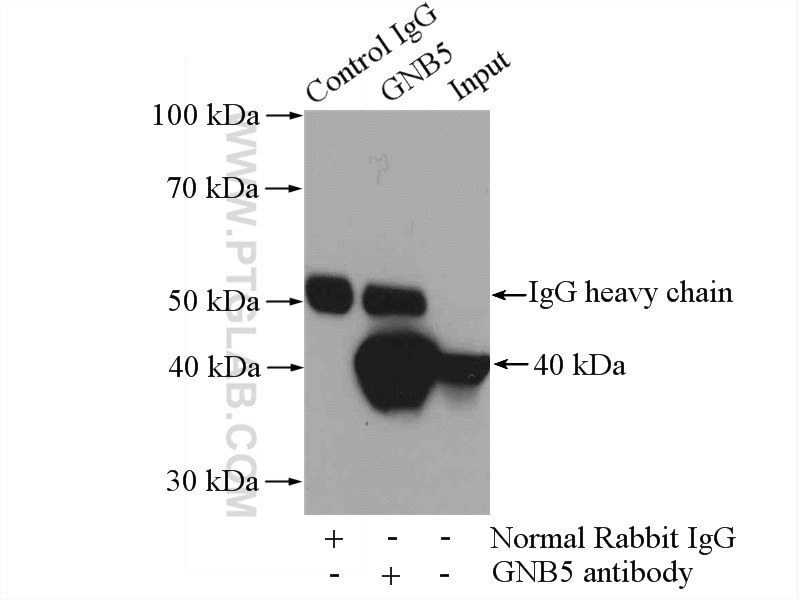- Phare
- Validé par KD/KO
Anticorps Polyclonal de lapin anti-GNB5
GNB5 Polyclonal Antibody for WB, IP, IHC, ELISA
Hôte / Isotype
Lapin / IgG
Réactivité testée
Humain, rat, souris
Applications
WB, IP, IF, IHC, ELISA
Conjugaison
Non conjugué
N° de cat : 11045-2-AP
Synonymes
Galerie de données de validation
Applications testées
| Résultats positifs en WB | tissu cérébral de souris, tissu cérébral humain |
| Résultats positifs en IP | tissu cérébral de rat |
| Résultats positifs en IHC | tissu de tumeur ovarienne humain, il est suggéré de démasquer l'antigène avec un tampon de TE buffer pH 9.0; (*) À défaut, 'le démasquage de l'antigène peut être 'effectué avec un tampon citrate pH 6,0. |
Dilution recommandée
| Application | Dilution |
|---|---|
| Western Blot (WB) | WB : 1:1000-1:6000 |
| Immunoprécipitation (IP) | IP : 0.5-4.0 ug for 1.0-3.0 mg of total protein lysate |
| Immunohistochimie (IHC) | IHC : 1:50-1:500 |
| It is recommended that this reagent should be titrated in each testing system to obtain optimal results. | |
| Sample-dependent, check data in validation data gallery | |
Applications publiées
| KD/KO | See 2 publications below |
| WB | See 6 publications below |
| IF | See 1 publications below |
Informations sur le produit
11045-2-AP cible GNB5 dans les applications de WB, IP, IF, IHC, ELISA et montre une réactivité avec des échantillons Humain, rat, souris
| Réactivité | Humain, rat, souris |
| Réactivité citée | rat, Humain, souris |
| Hôte / Isotype | Lapin / IgG |
| Clonalité | Polyclonal |
| Type | Anticorps |
| Immunogène | GNB5 Protéine recombinante Ag1518 |
| Nom complet | guanine nucleotide binding protein (G protein), beta 5 |
| Masse moléculaire calculée | 39 kDa |
| Poids moléculaire observé | 39-42 kDa |
| Numéro d’acquisition GenBank | BC011671 |
| Symbole du gène | GNB5 |
| Identification du gène (NCBI) | 10681 |
| Conjugaison | Non conjugué |
| Forme | Liquide |
| Méthode de purification | Purification par affinité contre l'antigène |
| Tampon de stockage | PBS avec azoture de sodium à 0,02 % et glycérol à 50 % pH 7,3 |
| Conditions de stockage | Stocker à -20°C. Stable pendant un an après l'expédition. L'aliquotage n'est pas nécessaire pour le stockage à -20oC Les 20ul contiennent 0,1% de BSA. |
Informations générales
Guanine nucleotide-binding proteins (G proteins) are involved as a modulator or transducer in various transmembrane signaling systems. The beta and gamma chains are required for the GTPase activity, for replacement of GDP by GTP, and for G protein-effector interaction. G proteins, which integrate signals between receptors and effector proteins, are composed of an alpha, a beta, and a gamma subunit.
Protocole
| Product Specific Protocols | |
|---|---|
| WB protocol for GNB5 antibody 11045-2-AP | Download protocol |
| IHC protocol for GNB5 antibody 11045-2-AP | Download protocol |
| IP protocol for GNB5 antibody 11045-2-AP | Download protocol |
| Standard Protocols | |
|---|---|
| Click here to view our Standard Protocols |
Publications
| Species | Application | Title |
|---|---|---|
Oncogene The Gβ5 protein regulates sensitivity to TRAIL-induced cell death in colon carcinoma.
| ||
J Cell Mol Med Prenatal hypoxia inhibited propionate-evoked BK channels of mesenteric artery smooth muscle cells in offspring. | ||
Neuropharmacology. A systems genetic analysis of alcohol drinking by mice, rats and men: Influence of brain GABAergic transmission. | ||
PMC Biophys Retinal cone photoreceptors require phosducin-like protein 1 for g protein complex assembly and signaling. | ||
MedComm (2020) Transcriptomic analysis of rat brain response to alternating current electrical stimulation: unveiling insights via single-nucleus RNA sequencing |







